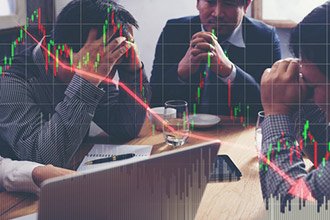July was a banner month for major market averages. The S&P 500 passed 3,000 on July 10, and then the Dow Jones Industrial Average reached its highest point in history on July 15.
But Wall Street, the Federal Reserve, and Congress are all pointing to a potential 2019 stock market crash.

If you take a closer look, you'll find there are significant stock market crash warnings on the horizon.
Of course, a 10-year bull market makes everything appear hopeful.
The problem is that appearances can deceive investors. And deceived investors can lose their ability to perceive risk entirely, ignoring any stock market crash warnings coming their way.
When they least expect it, the market side-steps.
They'll say they never saw it coming. But the truth is, they could have. They just had to pay attention.
YOU KNOW IT IN YOUR GUT: Look at how things are going. Financial turmoil is coming just around the corner, maybe just a few months away. Click here...
Our first warning sign of a stock market crisis this year comes straight from the Fed...
Potential 2019 Stock Market Crash Signs, No. 1: Inverted Yield Curve
The New York Federal Reserve has a model that measures the probability of recession in the coming year.
Recently, the model reached its highest reading since 2009, at 32.9%. The month before, it was roughly 28%. That's a big jump for one month.
Each time the measure has risen over 30% since 1960, a recession followed in fairly short order.
The New York Fed forecasts the model partly based on the spread between three-month and 10-year Treasury bond yields, known as the yield curve.
Whenever the line for short-term bonds climbs higher than yields on long-term bonds, the Federal Reserve views it as a signal of possible recession.
The Fed knows that an inverted yield curve has preceded every financial shock in the last 60 years.
Well, in just the past several months, we saw an inverted Treasury yield curve - the first to occur since the financial crisis of 2007.
One of the things an inverted yield curve signals is investor belief that future returns might drop. They're snapping up long-term bonds to protect against declining future returns.
Declining yields aren't just happening in the United States, either. It's a global phenomenon. In the United Kingdom, Japan, Germany, and Australia, yields on bonds have been dropping fast.
The moves indicate that investors globally are concerned about economic growth.
Which brings us to our next stock market crash signal...
Potential 2019 Stock Market Crash Signs, No. 2: a Slowing Chinese Economy
The Chinese economy has seen robust growth over the years. Until recently, the nation had gradually increased its gross domestic product (GDP) and the concomitant rising standard of living. Because China is the world's second-largest economy, this was good news for the world.
But it's no longer the case. China's GDP fell almost 0.5% last quarter. That's the lowest reading in more than 27 years.
China has blamed this on its trade war with the United States.
Scott Minerd, Guggenheim Partners' global chief investment officer, believes that the trade war could lead to a 2019 stock market crisis if tensions don't resolve.
He also forecasts that stock markets will drop below the levels reached in December 2018 - the Dow's worst week in 10 years - if the trade war remains in effect. That would signal the end of the bull market started in 2009.
But it isn't just trade war tensions emanating from the White House, either.
Here's how Congress might slow down the economy - and what you can do to prepare...
Potential 2019 Stock Market Crash Signs, No. 3: CECL
[mmpazkzone name="in-story" network="9794" site="307044" id="137008" type="4"]
CECL is an accounting rule that applies to American banks. It's shorthand for the "Current Expected Credit Loss" accounting standard.
If this legislation passes Congress, it will place more stringent lending rules on the biggest financial institutions in the United States.
The goal is to prevent the conditions of the financial crisis of 2008 from happening again.
But big banks don't want to see it go through. Under CECL, they would be held to certain amounts of deposits from new borrowers.
That's why Wall Street doesn't like CECL. In fact, there's a ton of lobbying in Congress to stop the new rule before it becomes law.
As a result, new bills are pending in both the Senate and the House to either prevent or delay the rollout. Because the rule is designed to avert a replay of the 2008 financial crisis, anything that stops it from going into effect means the next financial crisis could be worse than what we saw in 2008.
But if you know the signs - and you take measures to be ready when it comes - there are ways to soften the blow...
You Must Act Now: America is headed for an economic disaster bigger than anything since the Great Depression. If you lost out when the markets crashed in 2008, then you are going to want to see this special presentation. Because if you don't act soon, the effects on your financial future could be more severe than anything you have ever experienced. Don't wait - you can see all the details right here.


